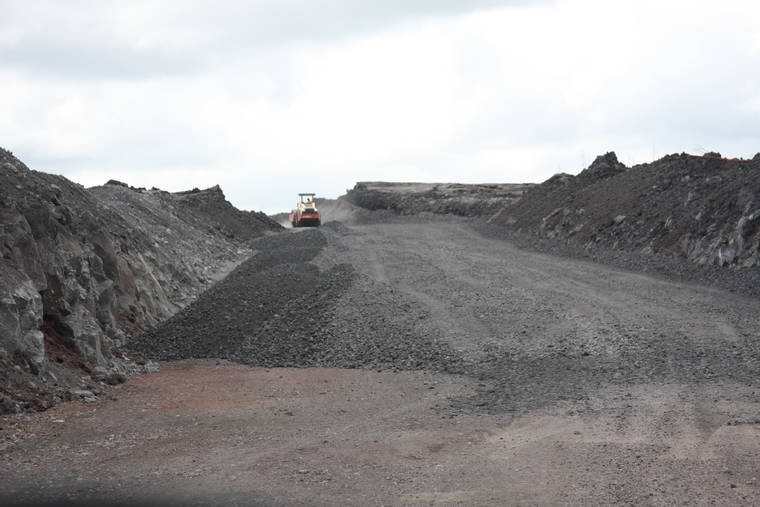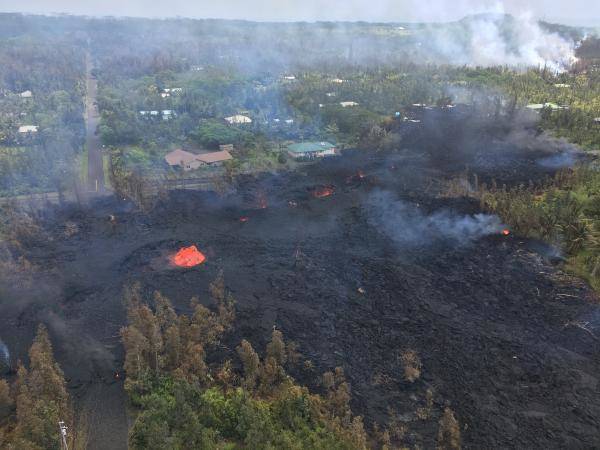Hawaii County could receive more than $300 million in state and federal funding to support recovery and response efforts stemming from the 2018 eruption of Kilauea volcano, but only a portion of funding has so far been obtained and even less has been spent as the county works to cement long-term recovery plans.
Recovery funds will be used to address a number of needs, such as replacing public infrastructure, housing and creating and implementing a recovery plan, but the various funding sources are subject to specific uses, regulations, guidelines and time restraints.
Nearly 14 square miles of land was inundated with lava during the months-long eruption, which destroyed more than 700 structures and homes in lower Puna and displaced 3,000 residents.
The eruption caused an estimated $236.5 million in damage to roads, waterlines and other facilities and $27.9 million in farm losses, resulting in decreased agriculture and floriculture production, and triggered a decrease in tourism revenue, among other impacts, according to the county’s Kilauea recovery website.
As of August, about $9.8 million has been spent on response and recovery activities, including $2.85 million on emergency work, $5.4 million on emergency labor and $1.59 million on other expenses.
“We’ve had definitely several (Federal Emergency Management Agency) disasters in our history,” county Finance Director Deanna Sako told the Tribune-Herald. “We are probably the most disaster-prone island in the state just in terms of the number of FEMA events. So we’re used to dealing with FEMA. … This is the first one that impacted this many people and (of) this magnitude, where we also needed people to come in and help us manage it.”
Sako said the county submitted requests to FEMA for initial emergency response expenses, which are in the process of coming in. But so far, FEMA has reimbursed the county $1.86 million.
“But now, we’re getting into more of the recovery phase and (asking) how do we recover from this, or what happens in that area,” Sako said. “… And this is where it’s really unprecedented for us. We’ve never had a disaster like this where we had to really plan what’s going to happen in that community and how we move forward.”
Among funding related to the eruption and recovery, the county received $12 million from Gov. David Ige’s office for response during the active eruption phase.
Sako said there was “definitely a lot of overtime that was not budgeted for by us that had to be spent, so that went to help cover that.”
The governor’s office gave an additional $10 million for issues such as health, safety, food, water, housing assistance and relocation planning.
Funds from the governor are not for private sector use or long-term infrastructure repairs.
The state Legislature also appropriated $20 million for relief, recovery, mitigation and remediation assistance.
“That piece, we’re spending a little more slowly,” Sako said. “We have several plans yet to come back — the recovery plan from our vendor, as well as some of the hazard mitigation and other studies that are being done. So then we’ll be able to best determine how we spend the $20 million.
“We’re very appreciative of it, and we are slowly spending and developing plans, but I think as the bigger plan comes back, we’ll have a better way to do that.”
Another $40 million loan from the Legislature is to be used for matching funds required for federal infrastructure projects.
Many FEMA projects require a 25% match.
“Right now, our estimate of our match is actually greater than $40 million, but we’ll work that out into our whole plan as that comes clearer in the coming weeks and months,” Sako said.
The county is in the midst of applying for an estimated $245 million in FEMA 428 funds, which would include $170 million for public road reconstruction projects, $38 million for water infrastructure and $37 million for park reconstruction projects, according to the recovery website.
Sako said normally FEMA wants infrastructure repaired to the state it was before a disaster.
FEMA 428 funding, however, allows for alternative projects and more flexibility. The funding is pending FEMA review and approval.
The county also will seek an estimated $60 million in U.S. Housing and Urban Development Community Development Block Grant-Disaster Relief funding.
The state announced in May it would receive $66.9 million in CDBG Disaster Relief funding, a portion of which Hawaii County can apply for.
“However, for that funding to be available to us to apply, they have to publish their federal register notice,” said Ali Slous, Kilauea disaster recovery program coordinator. “So they have not published the federal register notice yet, and that will let us know how much we’re eligible to apply for, and it will also let us know the kind of rules and guidelines and requirements for the program.”
But to receive the funds, the county knows there will be “a few major deliverables,” Slous said.
One is an implementation plan to ensure the county has policies, processes and staffing in place to implement the grant, and the second is an action plan to outline what the money will be used for.
It is unknown when the federal register will be published.
The county received a handful of other grants for recovery, including a $1.68 million FEMA disaster case management grant. It also received a $150,000 donation from Puna Geothermal Venture and donations of $29,245 from Japan.
“… We have this big disaster, we get access to different kinds of funding sources than we have before. Some are highly flexible and we can do basically what we can do, and some are highly restrictive,” Slous said. “And so part of the challenge of this team is to build capacity for the funding streams that we’ve never handled before, and that we’ll greatly need to increase our staffing to be able to manage, for example, a $60 million CDBG-DR award.”
The county also has to meet individuals’ needs now, “and help them get back to some semblance of normalcy while being very strategic about how we spend down the flexible funds,” she said. “We may not have enough money to do everything we want to do, and so there’s this strategic element to how we utilize the funds over time, such that when we get to the long-term strategic plan, that we still have enough to do some of those larger initiatives.”
Sako said priorities “rise up to the surface.”
“We’re obviously aware of a lot of community needs, and so we’re trying to make the programs work within all of our government rules and regulations to get the money to the people who need it,” she said. “But I think one of the challenges is definitely working within federal law, state law, county laws, and then also … the restrictions placed on the money to us.”
Slous said, too, “this isn’t the end, necessarily,” because there is other funding that could be sought, depending on needs.
For more information about funding, visit recovery.hawaiicounty.gov/progress/recovery-funding.
Email Stephanie Salmons at ssalmons@hawaiitribune-herald.com.











